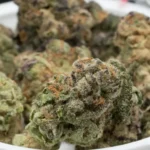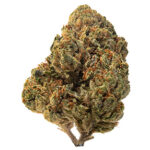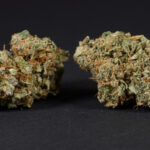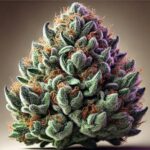Discover Grape Ape, the indica-dominant strain with Afghani x Mendocino Purps x Skunk #1 genetics. Learn about its multiple Cannabis Cup wins, 25% THC levels, grape-like effects, and growing characteristics. Complete strain guide with cultivation tips.
Grape Ape Strain Review: The Award-Winning Indica Powerhouse Complete Guide
Introduction
Grape Ape stands as one of the most visually striking and award-winning cannabis strains ever developed, earning its reputation as the “indica-hybrid king of the cannabis jungle.” This predominantly indica strain, with its distinctive purple-dominated coloration and authentic grape-like aroma, has captured the hearts of cannabis enthusiasts worldwide since its introduction in the early 2000s. With THC levels reaching up to 25% and a trophy case filled with prestigious awards, Grape Ape represents the perfect combination of visual appeal, exceptional flavor, and powerfully relaxing effects.
Originally bred by Apothecary Genetics with contributions from Barney’s Farm, this strain has maintained its popularity for over two decades, consistently delivering the heavy-hitting, grape-flavored experience that made it legendary. Its success in competitions, including back-to-back wins at the Green Cup in 2005 and 2006, demonstrates not just momentary excellence but sustained quality that continues to impress both judges and consumers.
Genetics and Lineage
Parent Strains
Grape Ape’s exceptional qualities result from the masterful three-way crossing of legendary genetics:
Mendocino Purps (Mendo Purps): This indica strain from Mendocino County, Northern California, contributes the deep purple hues and earthy flavor profile that Grape Ape is famous for. Winner of Leafly’s Strain of the Year in 2007, Mendocino Purps brings more than just grape flavor—it also contributes the potentially sleepy and giggly effects that make Grape Ape so distinctive.
Skunk #1: This legendary hybrid strain lends Grape Ape its skunky smell and robust genetic foundation. Beyond its aromatic contribution, Skunk #1 brings the reported appetite-inducing effects and adds stability to the overall genetic profile. Its high CBG content in the parent genetics also contributes to Grape Ape’s therapeutic potential.
Afghani: This pure indica landrace strain from Afghanistan represents one of the earliest varieties of cannabis, prized by breeders for its heavy resin content and potent effects. Afghani contributes the deeply relaxing and sedative qualities that make Grape Ape ideal for evening use, while also enhancing resin production for extraction purposes.
Genetic Profile
Indica/Sativa Ratio: 90% Indica / 10% Sativa (some sources report pure indica) THC Content: 16-25% (average around 18-20%) CBD Content: Low (typically less than 1%) CBG Content: Notably present due to parent genetics Flowering Time: 7-8 weeks Grow Difficulty: Easy to moderate
Awards and Recognition
Grape Ape has accumulated an impressive collection of awards since its introduction:
Major Competition Wins
- Green Cup 2005: 1st Place
- Green Cup 2006: 1st Place (back-to-back victory)
- High Times Medical Colorado Cup 2011: Best Concentrate (1st Place)
- Multiple regional competitions: Various placements and wins
Industry Recognition
- Leafly featured strain: Regular highlighting in cannabis publications
- Dispensary favorite: Consistently popular across legal markets
- Breeder acclaim: Recognized for stable genetics and consistent quality
- Medical community endorsement: Valued for therapeutic applications
Physical Characteristics
Appearance
Grape Ape is immediately recognizable by its stunning visual characteristics:
- Deep purple dominance: More purple than green coloration in quality phenotypes
- Dense, resinous buds with compact structure
- Orange and copper-colored stigmas adding color complexity
- Thick white trichome coating creating a frosted appearance
- Spade-shaped, chunky flowers typical of indica genetics
- Medium to large bud size with exceptional density
The strain’s “tremendous bag appeal” makes it one of the most photogenic varieties available, often featuring purple coloration so dominant that green becomes secondary.
Aroma and Flavor Profile
Primary Terpenes:
- Myrcene: Provides herbal, musky base notes characteristic of indicas
- Caryophyllene: Contributes peppery spice and anti-inflammatory properties
- Limonene: Adds citrus brightness balancing heavier elements
- Pinene: Provides fresh, piney notes that complement the fruit flavors
Aromatic Experience:
- Primary: Strong grape-forward aroma reminiscent of ripe grapes
- Secondary: Earthy, herbal undertones with berry notes
- Tertiary: Pungent sweetness mixed with dark fruit and musk
Flavor Profile:
- Inhale: Sweet grape candy with earthy complexity
- Mid-palate: Traditional grape-flavored sweets with herbal spice
- Exhale: Lingering grape sweetness with earthy, musky finish
True to its name, Grape Ape delivers an authentic grape experience that rivals traditional grape-flavored products while maintaining sophisticated cannabis complexity.
Effects and Experience
Primary Effects
Physical Sensations:
- Deep, full-body relaxation leading to potential couch-lock
- Heavy-hitting sedative effects ideal for evening use
- Pain relief for chronic conditions
- Muscle tension release and physical tranquility
- Sleep induction in moderate to higher doses
Mental Experience:
- Euphoric onset with mood elevation
- Stress and anxiety relief
- Happy, relaxed mental state
- Giggly effects reported by many users
- Mental calmness progressing to sleepiness
Onset and Duration
Experience Timeline:
- Initial phase: Slow onset building to peak effects
- Peak experience: Heavy dose of total relaxation
- Duration: Effects linger for 2-4 hours
- Comedown: Gradual transition often leading to sleep
Intensity Characteristics:
- Potent but manageable for experienced users
- Can overwhelm novice users due to indica dominance
- Consistent effects across different phenotypes
- Reliable experience making it popular for regular use
Medical Applications
Grape Ape has proven particularly valuable for numerous medical conditions:
Primary Medical Uses
Pain Management:
- Chronic pain conditions: Significant analgesic properties
- Inflammatory conditions: Anti-inflammatory terpene profile
- Arthritis and joint pain: CBG content may contribute to relief
- Muscle spasms and tension: Deep relaxation properties
Mental Health Applications:
- Stress and anxiety: Calming effects provide significant relief
- Depression: Mood-lifting and euphoric properties
- PTSD: Soothing effects help manage trauma symptoms
- Chronic stress: Deep relaxation combats stress-related symptoms
Sleep and Appetite:
- Insomnia: Strong sedative effects promote restful sleep
- Sleep disorders: Helps regulate sleep cycles naturally
- Appetite stimulation: Effective for eating disorders and chemotherapy side effects
- Nausea relief: Anti-emetic properties particularly when combined with other indica strains
Other Therapeutic Applications:
- Inflammation: Terpene profile provides anti-inflammatory benefits
- Seizure disorders: Some patients report symptom management
- Attention disorders: Calming effects may help with ADD/ADHD
- Cancer treatment support: Appetite stimulation and pain relief
Cultivation Information
Growing Characteristics
Plant Structure:
- Compact, bushy growth typical of indica genetics
- Strong branching supporting dense, heavy buds
- Short to medium height suitable for various growing spaces
- Thick, resinous colas requiring support during flowering
- Fast flowering time at 7-8 weeks
Growing Advantages:
- Easy to moderate difficulty suitable for less experienced growers
- Good pest resistance due to robust genetics
- Manageable size for indoor cultivation
- High resin production ideal for concentrate production
- Consistent genetics providing reliable results
Cultivation Tips
Indoor Growing:
- Climate control: Maintain temperature between 68-77°F
- Humidity management: Keep humidity levels between 40-50% during flowering
- Lighting: Responds well to both HID and LED lighting systems
- Training techniques: LST and SCROG maximize yields in limited space
- Support systems: Install support for heavy branches early in flowering
Outdoor Cultivation:
- Climate preferences: Thrives in Mediterranean-style conditions
- Harvest timing: Early to mid-October in Northern Hemisphere
- Space requirements: Allow adequate room for bushy growth pattern
- Soil preparation: Prefers rich, well-draining soil with organic amendments
- Pest monitoring: Regular inspection despite good natural resistance
Growing Challenges and Solutions
Potential Issues:
- Dense bud structure may be prone to mold without proper airflow
- Heavy branches require adequate support systems
- Purple coloration may indicate nutrient issues if appearing too early
- Resin production can attract pests during late flowering
Solutions:
- Proper ventilation and air circulation systems
- Plant support installed before buds become too heavy
- Nutrition monitoring to distinguish genetic purple from deficiency
- Integrated pest management throughout the growing cycle
Consumption Guidelines
Dosage Recommendations
New Users: Start with 1-2 small hits due to potentially overwhelming effects Moderate Users: Standard dosing with awareness of indica dominance Experienced Users: Can handle larger doses but should plan for sedative effects Medical Patients: Work with healthcare providers for optimal therapeutic dosing
Consumption Methods
Flower Options:
- Smoking: Traditional method showcasing full flavor profile
- Vaporizing: Preserves terpenes while reducing respiratory irritation
- Joints and blunts: Popular for social consumption despite potency
Concentrate Applications:
- Hash production: High resin content ideal for traditional hash
- Rosin pressing: Solventless extraction preserves terpene profile
- Live resin: Captures full aromatic complexity
- Bubble hash: Showcases trichome quality and potency
Best Usage Times
Optimal Timing:
- Evening relaxation after daily responsibilities
- Nighttime use for sleep assistance
- Weekend downtime when deep relaxation is desired
- Stress relief during particularly difficult periods
- Pain management during chronic condition flare-ups
Side Effects and Precautions
Common Side Effects:
- Cotton mouth: Stay well-hydrated during use
- Red eyes: Eye drops may provide comfort
- Heaviness and disorientation: Particularly affecting novice users
- Couch-lock: Plan for limited mobility after consumption
- Increased appetite: Prepare snacks in advance
Safety Precautions:
- Avoid driving or operating machinery after use
- Plan adequate time for effects to wear off completely
- Start with small amounts due to potentially overwhelming effects
- Create comfortable environment for relaxation experience
Market Presence and Consumer Reception
Commercial Success
Grape Ape maintains strong market performance:
- Premium positioning: Commands higher prices due to quality and recognition
- Consistent availability: Maintained across multiple legal markets
- Brand recognition: Name and visual appeal drive consumer interest
- Quality reputation: Known for reliable effects and consistent potency
Consumer Feedback
Positive Reviews Consistently Highlight:
- Authentic grape flavor: Genuinely delivers on its name’s promise
- Visual appeal: Stunning purple coloration and bag appeal
- Reliable effects: Consistent relaxation and pain relief
- Medical efficacy: Effective for various therapeutic applications
- Sleep aid: Highly valued for insomnia management
Areas of Consideration:
- Potency warnings: Some users find effects too sedating
- Timing importance: Not suitable for daytime use for most people
- Tolerance considerations: Regular use may require higher doses
- Availability fluctuations: High demand can create supply challenges
Cultural Impact and Legacy
Industry Influence
Grape Ape has significantly influenced cannabis culture:
- Visual standards: Set expectations for colorful, appealing cannabis
- Flavor profiles: Demonstrated potential for authentic fruit flavors
- Medical applications: Helped establish indica strains for therapeutic use
- Breeding programs: Genetics used in developing numerous purple strains
Related Strains and Offspring
Grape Ape genetics have contributed to various related varieties:
- Purple-themed crosses using Grape Ape genetics
- Mendocino Purps descendants carrying similar characteristics
- Fruit-flavored varieties inspired by its authentic grape profile
- Medical-focused strains building on its therapeutic reputation
Future Prospects
Continued Relevance
As cannabis markets mature, Grape Ape continues to maintain relevance:
- Genetic preservation: Multiple breeders maintaining quality genetics
- Medical research: Potential for further therapeutic application studies
- Extract market growth: High-quality concentrates increasing demand
- Consumer education: Growing appreciation for authentic terpene profiles
Innovation Opportunities
Potential Developments:
- New crosses incorporating Grape Ape genetics with modern varieties
- Concentrate innovations showcasing its unique terpene profile
- Medical formulations targeting specific therapeutic applications
- Cultivation improvements enhancing color development and yields
Conclusion
Grape Ape represents the gold standard of what an indica-dominant strain should be—visually stunning, authentically flavored, and consistently effective for both recreational and medical applications. Its two-decade journey from innovative breeding project to cannabis legend demonstrates the enduring appeal of strains that successfully combine exceptional genetics with genuine therapeutic value.
The strain’s multiple award wins, including consecutive Green Cup victories, weren’t just recognition of its quality at a specific moment, but acknowledgment of its lasting excellence. Its ability to maintain popularity and effectiveness across changing cannabis markets speaks to the fundamental soundness of its genetics and the skill of its original breeders.
For medical patients, Grape Ape offers reliable relief from chronic pain, insomnia, anxiety, and numerous other conditions without the complexity of highly psychoactive sativas. Its consistent effects and well-documented therapeutic applications make it a trusted option for those seeking predictable medical outcomes.
Recreational users appreciate Grape Ape for its authentic grape flavor, stunning visual appeal, and reliable relaxation effects that make it perfect for evening unwinding. The strain’s ability to deliver genuine grape flavor while providing potent therapeutic effects represents the best of what modern cannabis breeding can achieve.
Cultivators value Grape Ape for its relatively easy growing requirements, fast flowering time, and exceptional resin production that makes it ideal for both flower and concentrate production. Its stable genetics and consistent performance have made it a favorite among growers seeking reliable, high-quality results.
As the cannabis industry continues to evolve, Grape Ape stands as a testament to the importance of preserving proven genetics while continuing to innovate. It represents not just a successful strain, but a model for what cannabis breeding should aspire to achieve—authentic flavors, consistent effects, therapeutic value, and enduring appeal that transcends trends and fads.
Whether you’re seeking effective medical relief, authentic grape flavor, or simply want to experience one of the most awarded strains in cannabis history, Grape Ape delivers an experience that has satisfied cannabis enthusiasts for over twenty years. As always, consume responsibly and in accordance with local laws and regulations.




